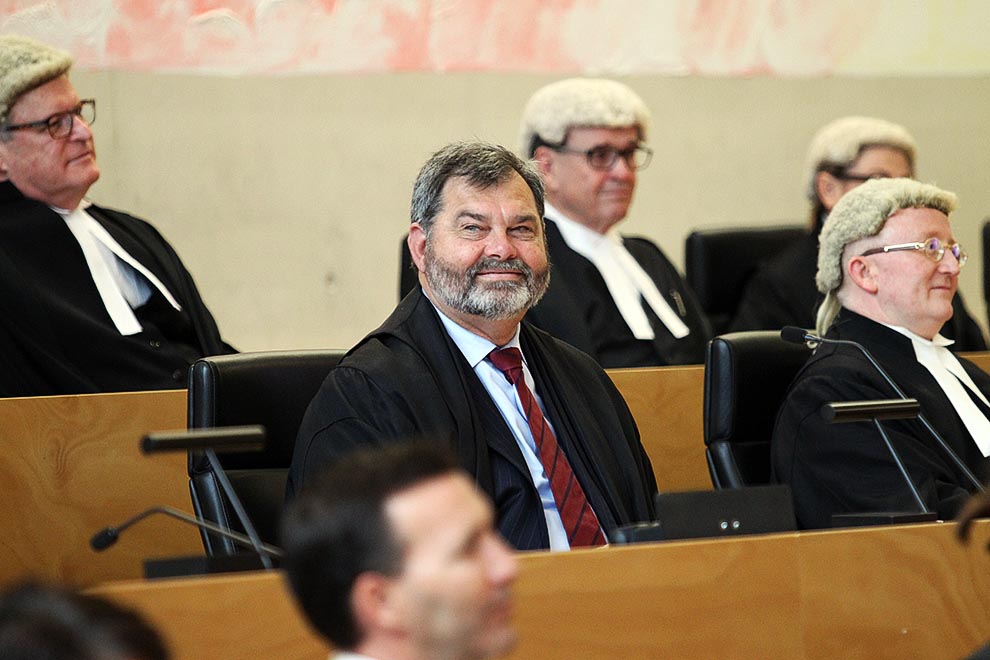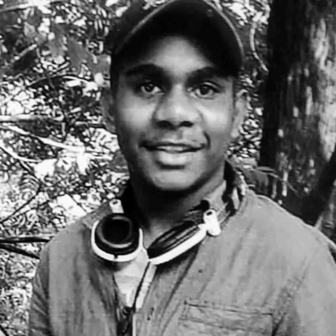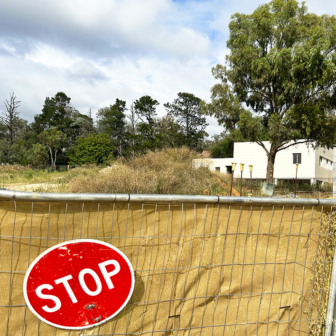Among a government’s more obvious legacies are the judges it appoints, who can serve for quite some time after prime ministers and premiers have been ejected from office. Justice Susan Kiefel, for instance, was appointed to the High Court by John Howard in 2007; she is entitled to stay there until 2024, a full seventeen years after the demise of the government that chose her.
In January, less than three years after winning power with a historic majority, premier Campbell Newman was spectacularly ejected from office in Queensland. But while his government has gone, Newman’s controversial appointment of Tim Carmody as chief justice in July last year continues to be a running sore for the state’s judiciary. Many senior judges and legal figures view as intolerable the prospect of Carmody’s remaining in office until his mandatory retirement, at the age of seventy, in twelve years’ time.
Recent developments, which have plunged the Queensland judiciary into renewed public rancour, can’t be fully appreciated without an understanding of the circumstances of Carmody’s appointment as chief justice. I have previously written a detailed account for Inside Story, so here I will simply recall the fact that when Carmody was sworn in as chief justice he was surrounded by chairs left empty by every single serving member of the Supreme Court, all of whom had boycotted the ceremony. It would take a person possessed of exceptional qualities to overcome such an inauspicious start.
Nine months on, it is clear that any attempt Carmody has made to win the respect of his colleagues has failed. Indeed, if the claims made against him are to be believed, he has only managed to antagonise them further and confirm his unsuitability for the post. Just a few days into the New Year a Guardian report unfavourably compared the number of published decisions Carmody had made during his six months as chief justice (three) with the number managed by his predecessor Paul de Jersey during the previous six months (twenty). It was de Jersey’s appointment as state governor that cleared the way for Carmody’s rapid elevation from the position of chief magistrate, which he had held for less than a year. The Guardian also highlighted the number of Carmody’s decisions overturned by the Court of Appeal.
On 23 March, the president of the Court of Appeal, Justice Margaret McMurdo, released a statement correcting press reports that she was opposed to televised court proceedings, a matter under review by a committee of judges at Carmody’s instigation. She revealed that although the chief justice had publicly announced his support for televised proceedings, he had vacated the role of committee chair, citing “time pressures and other demands.” McMurdo herself has taken on chairing of the committee and responsibility for its forthcoming public consultation.
All this was just the smouldering background to an incendiary valedictory speech given by Justice Alan Wilson on 26 March to mark his retirement from the Supreme Court. Carmody was overseas, but in the audience were judges from all the Queensland courts, as well as members of the federal judiciary who are based in Queensland, including Justices Kiefel and Keane of the High Court of Australia.
To describe Wilson’s remarks about the chief justice simply as a parting shot would be grossly inadequate. His staggering volley of missiles described in detail the dispiriting effect on the state’s judiciary of “being publicly represented by a chief justice for whom most now lack all respect” and cited four features of Carmody’s tenure by way of explanation. First, there was the matter of the amount of casework performed by the chief justice. Wilson claimed that Carmody had not sat on a hearing since 15 February and “has withdrawn himself from all published court calendars, so nobody knows when or whether he intends sitting again.” He also pointed to Carmody’s absence from trial division sittings in Brisbane and his professed intention to sit only occasionally in the Court of Appeal.
Second, Wilson revealed that Carmody had sacked Justice John Byrne from the post of senior judge administrator, the head of the Trial Division, and had only reversed the decision after an outcry from the other members of the court. Third, and perhaps most damaging of all, Wilson claimed that Carmody had attempted to depart from the longstanding protocol under which judges are appointed to sit on the Court of Disputed Returns in strict order of seniority. That court decides disputes that arise in the wake of state elections – and such disputes were a very live possibility given the closeness of the vote in some seats in January. Last, said Wilson, Carmody had referred collectively to his colleagues as “snakes” and “scum” and failed to treat them with civility or courtesy.
Carmody’s initial response to these criticisms was to reject them outright. He also made the unexpected observation that Wilson’s behaviour was “the best argument yet for an independent judicial commission.” Whether the chief justice meant a commission to handle judicial appointments or one to deal with judicial misconduct was unclear. The latter seems illogical given Wilson’s imminent departure from the court. As for the former, many critics have already cited Carmody’s own elevation to the state’s highest judicial office as evidence of the need for a more formal and depoliticised appointment process overseen by an independent commission.
After his return from Papua New Guinea, Carmody wrote to the presidents of the Queensland Bar Association and the Queensland Law Society expressing a preference that Wilson’s allegations “be discussed and resolved internally within the judiciary and legal profession… rather than damaging the institutional reputation of the judiciary through the public airing of grievances.” But since the claims had been made in public some response in kind was required, and so Carmody’s letter was also sent to the Courier-Mail for publication.
It is curious that the chief justice thought he could adopt this strategy and yet confine himself to addressing just two of the criticisms. Surprisingly, he made no reference whatsoever to Wilson’s claim that he had sacked the senior judge administrator and then reversed the decision under pressure from the other judges. Nor did he respond to the claim that he had made derogatory references about his judicial colleagues. These omissions from Carmody’s own defence were seized on by Terry O’Gorman of the Queensland Council for Civil Liberties, who has called on the chief justice to provide the facts of what occurred.
O’Gorman and other members of the profession have also challenged the adequacy of Carmody’s detailed response to the other two criticisms. Barristers Stephen Keim and Alex McKean have unpicked the chief justice’s defence of his sitting arrangements, highlighting inconsistencies between information in his engagement calendar and the dates he discusses in his letter. They argue that he hadn’t adequately communicated his intentions beyond advising some members of staff in the court registry, and concluded that – even on the most favourable tally – the chief justice appears to have had a “significant period away from the coalface” and looks likely to spend just eighteen weeks in court during the eight-month period to November.
But this was as nothing compared to the questions raised by Carmody’s attempted clarification of the matter of the Court of Disputed Returns. Carmody correctly stated that section 137 of the Electoral Act (Qld) vests the power of constituting that court in the chief justice. But he asserted that a departure from the protocol whereby senior judges are automatically appointed to this body may be justified in cases where sticking to the protocol would not “ensure the appearance of neutrality.” It is this statement that has generated great disquiet.
Given that the appointments did eventually follow the protocol, O’Gorman has asked the chief justice to explain why he thought the choice of those particular individuals – both of them senior judges – might have failed to “ensure the appearance of neutrality”? Keim and McKean have suggested that Carmody doesn’t deserve much credit for eventually sticking to the protocol, given that he did so on the very day the Electoral Commission announced it would not be seeking a Court of Disputed Returns hearing into the result in the seat of Ferny Grove, which was hugely important to securing Labor’s narrow victory in the state election. They also query the value of a protocol that the chief justice says “must yield to the circumstances of the day” and express dissatisfaction about his failure to respond to Wilson’s related allegations that he attempted to speak privately with one of the nominated judges about his “unresolved concerns.”
The whole business, in other words, is a lamentable mess. A highly respected figure has made scathing criticisms of Queensland’s highest judicial officer to a large audience made up of members of the state and national judiciaries, and these criticisms are now on the public record (on the website of the Supreme Court’s own library, no less). The chief justice has offered a partial defence that is viewed by most observers as seriously inadequate. The president of the Bar Association, Mr Shane Doyle QC, has felt unable to respond to Carmody’s request for the organisation’s assistance in bringing the “destabilisation” to an end with anything more than an assurance that his organisation “is attempting to fully understand the circumstances which give rise to the present issues, and will seek to contribute to a mature and constructive resolution of those issues in whatever way is possible.”
Despite those careful words, the affair has riven the Bar Association. Just a day before Wilson’s valedictory remarks, Peter Davis QC – who resigned as the association’s president over the government’s handling of the consultations before Carmody’s appointment – was presented with life membership of the association. In a fiery acceptance speech he accused the association of suffering from “identity crisis” and severely criticised its attendance at Carmody’s swearing-in.
Judges talk a lot about the importance of public confidence in the courts, which is essential to their power and authority in the community. At the time he was appointed, the fears that Carmody was not up to the job – deepened by his ill-advised acknowledgement that he was rarely “the smartest lawyer in the room” – led to predictions that the new chief justice would damage that confidence. Rarely have such fears been so swiftly or dramatically borne out. With a divided legal profession looking with dismay on a demoralised and fractious judiciary, how can public respect and faith in the courts not be suffering?
But what is to be done? The new premier, Annastacia Palaszczuk, whose infant government is clinging to power in the wake of Billy Gordon’s expulsion from the Labor Party, has little time for a replay of the public bitterness that accompanied Carmody’s appointment in 2014. With palpable exasperation, she declared that “enough is enough... the time has come now for there to be stability.” This is about all she can do, for any attempt by the government to resolve the tensions between the judges risks being seen as an interference in the independence of the judiciary – one of the gravest criticisms of the Newman government’s conduct.
As in other Australian jurisdictions, Queensland’s constitution provides that judges may only be removed by the governor-in-council on an address by the Legislative Assembly for “proved misbehaviour justifying removal from the office” or “proved incapacity to perform the duties of the office.” Such a move would be the culmination of a complex process involving an investigation by a specially constituted tribunal. No one – not even his most trenchant critics – has suggested that the chief justice has engaged in any conduct that might be viewed as “misbehaviour” supporting the case for his removal under the constitution.
Instead, the talk is all about Carmody facing up to the fact that his position is simply untenable and making what Graeme Orr calls “a face-saving exit.” To be frank, it is hard to believe this is possible. The reputational damage that Carmody has weathered since his appointment was announced ensures that his departure would simply be an “exit.” This may explain his remarkable tenaciousness in the face of criticism that would wilt many others. He has nothing to lose and everything to prove.
In his letter to the Bar Association and the Law Society, Carmody declared that he would not be “bullied out of judicial office.” And there, as they say, is the rub. If he won’t go, then no one can force him to. The trashing of his reputation only succeeds as a strategy to bring about his departure if he lets it. If, as appears to be the case, he chooses to dig in, then no one wins and everyone – the chief justice, the other judges and the court, the profession and the community – loses from the public airing of grievances over his leadership, no matter how legitimate those may be.
Security of judicial tenure has been integral to the institutional independence of the judiciary since the Act of Settlement was enacted by the English parliament in 1700. It is the ancestor of those provisions in Australia’s national, state and territory constitutions that protect judges from the threat of political interference or removal. Carmody’s plight is distinctive because it is his colleagues who want him gone. Yet they possess no constitutional power, let alone mechanism, to bring about that result.
Nor, to be blunt, should they. Judicial independence, as the High Court’s Justice Dyson Heydon reminded us before his retirement, includes independence from other judges. Heydon was discussing the reasoning process when judges decide cases together on an appellate court, and insisted that judges should be on guard against blandishments from colleagues designed to obtain agreement to outcomes with which they might otherwise disagree. The dire impasse in the Supreme Court of Queensland is, of course, entirely outside the dynamics of normal judicial decision-making, but the core of the principle holds: judges should be free from interference in the performance of their duties.
There is a certain irony in invoking the principle of judicial independence in defence of Tim Carmody. Both before and after his appointment as chief justice it has been alleged that he was unacceptably close to government and also, in respect of the recent Court of Disputed Returns claim, that he was prepared to upset established processes designed to ensure judicial impartiality. It also offers no solution to the enormous problem of what Wilson called “the current experiment” of having a chief justice who “frankly admits” he lacks the legal ability necessary to attract the respect of those serving alongside and under him. As Orr says, the Supreme Court “is in a terrible bind.” Its members not only view Carmody as ill-equipped for his office but also resent him for a range of specific reasons, the validity of which he has been unable to convincingly dispel. Rail as they might, however, the judges are stuck with him.
The lesson from all this, of course, is that it is vital to get things right at the time of appointment. With judicial tenure secure except in the most extreme cases, it is important that those selected for judicial office are unquestionably able and respected. This doesn’t mean that the power of appointment should simply be abdicated by the executive to the judiciary and the legal profession. Sitting judges should not be left to choose their colleagues and successors, lest they, unconsciously or otherwise, prefer the appointment of those persons with experiences and backgrounds similar to their own. That would slow the development of a more diverse judiciary in Australian courts.
It does mean, however, that governments should approach the task of appointment with earnest good faith and a willingness to consult and listen. Instead, Premier Newman and his attorney-general capped off a turbulent relationship with the Queensland legal profession by appointing Tim Carmody as the state’s chief justice with full knowledge of how that would be received and the reasons why.
His government has been consigned to history, but Queensland is still in the grip of Newman’s most contentious legacy – his decision to use the opportunity to appoint a new chief justice as a deliberate provocation to the state’s judiciary. It may be small comfort to Carmody’s critics and offer no resolution to the simmering tensions that persist in the Supreme Court, but the political cost Newman incurred for that decision is the best guarantee we have that governments will not approach future appointments in the same spirit. •




